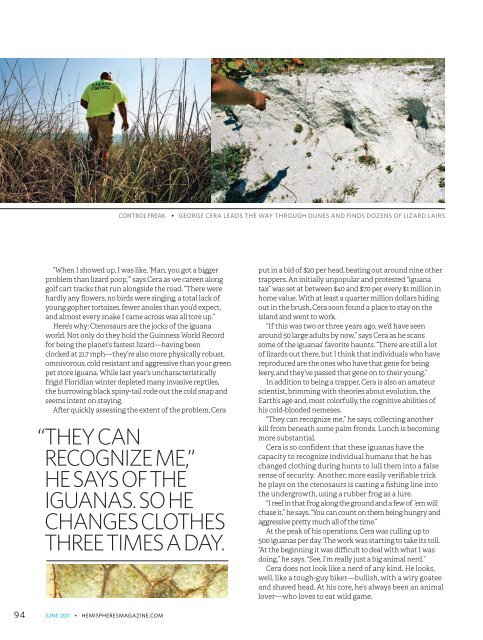june-2011
june-2011
june-2011
You also want an ePaper? Increase the reach of your titles
YUMPU automatically turns print PDFs into web optimized ePapers that Google loves.
94<br />
“When I showed up, I was like, ‘Man, you got a bigger<br />
problem than lizard poop,’” says Cera as we careen along<br />
golf cart tracks that run alongside the road. “There were<br />
hardly any fl owers, no birds were singing, a total lack of<br />
young gopher tortoises, fewer anoles than you’d expect,<br />
and almost every snake I came across was all tore up.”<br />
Here’s why: Ctenosaurs are the jocks of the iguana<br />
world. Not only do they hold the Guinness World Record<br />
for being the planet’s fastest lizard—having been<br />
clocked at 21.7 mph—they’re also more physically robust,<br />
omnivorous, cold resistant and aggressive than your green<br />
pet store iguana. While last year’s uncharacteristically<br />
frigid Floridian winter depleted many invasive reptiles,<br />
the burrowing black spiny-tail rode out the cold snap and<br />
seems intent on staying.<br />
A er quickly assessing the extent of the problem, Cera<br />
“ THEY CAN<br />
RECOGNIZE ME,”<br />
HE SAYS OF THE<br />
IGUANAS. SO HE<br />
CHANGES CLOTHES<br />
THREE TIMES A DAY.<br />
JUNE <strong>2011</strong> • HEMISPHERESMAGAZINE.COM<br />
CONTROL FREAK • GEORGE CERA LEADS THE WAY THROUGH DUNES AND FINDS DOZENS OF LIZARD LAIRS<br />
put in a bid of $20 per head, beating out around nine other<br />
trappers. An initially unpopular and protested “iguana<br />
tax” was set at between $40 and $70 per every $1 million in<br />
home value. With at least a quarter million dollars hiding<br />
out in the brush, Cera soon found a place to stay on the<br />
island and went to work.<br />
“If this was two or three years ago, we’d have seen<br />
around 50 large adults by now,” says Cera as he scans<br />
some of the iguanas’ favorite haunts. “There are still a lot<br />
of lizards out there, but I think that individuals who have<br />
reproduced are the ones who have that gene for being<br />
leery, and they’ve passed that gene on to their young.”<br />
In addition to being a trapper, Cera is also an amateur<br />
scientist, brimming with theories about evolution, the<br />
Earth’s age and, most colorfully, the cognitive abilities of<br />
his cold-blooded nemeses.<br />
“They can recognize me,” he says, collecting another<br />
kill from beneath some palm fronds. Lunch is becoming<br />
more substantial.<br />
Cera is so confi dent that these iguanas have the<br />
capacity to recognize individual humans that he has<br />
changed clothing during hunts to lull them into a false<br />
sense of security. Another, more easily verifi able trick<br />
he plays on the ctenosaurs is casting a fi shing line into<br />
the undergrowth, using a rubber frog as a lure.<br />
“I reel in that frog along the ground and a few of ’em will<br />
chase it,” he says. “You can count on them being hungry and<br />
aggressive pre y much all of the time.”<br />
At the peak of his operations, Cera was culling up to<br />
500 iguanas per day. The work was starting to take its toll.<br />
“At the beginning it was diffi cult to deal with what I was<br />
doing,” he says. “See, I’m really just a big animal nerd.”<br />
Cera does not look like a nerd of any kind. He looks,<br />
well, like a tough-guy biker—bullish, with a wiry goatee<br />
and shaved head. At his core, he’s always been an animal<br />
lover—who loves to eat wild game.
















